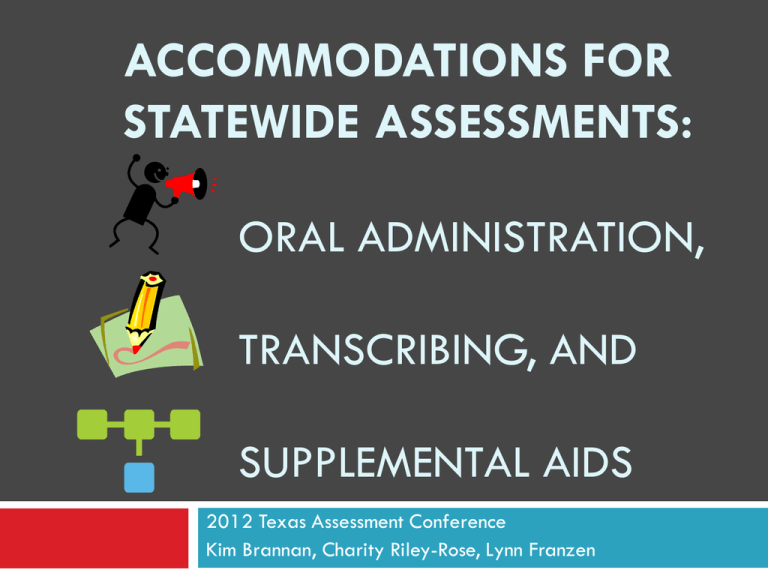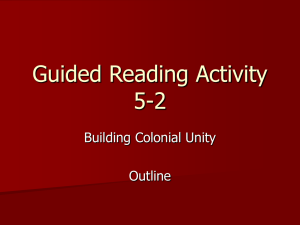
ACCOMMODATIONS FOR
STATEWIDE ASSESSMENTS:
ORAL ADMINISTRATION,
TRANSCRIBING, AND
SUPPLEMENTAL AIDS
2012 Texas Assessment Conference
Kim Brannan, Charity Riley-Rose, Lynn Franzen
Agenda
2
General Information about Accommodations
Oral Administration
Transcribing
Supplemental Aids
Questions?
TEA November 2012
3
General Information
about Accommodations
TEA November 2012
Accommodations…
4
Are changes to instructional materials, procedures, or
techniques that allow a student with a disability to
participate meaningfully in grade-level or course instruction
Should be effective in allowing a student access to the TEKS
Are not changes to the Texas Essential Knowledge and Skills
(TEKS)
Should not be provided to a student without evidence of
effectiveness, because student need is likely to change from year
to year
Must be individualized for each student
Should not be provided to an entire group of students (e.g., all
students in a classroom, all students within the same disability
category)
Any accommodation may be
appropriate for classroom use.
BUT some
accommodations may
not be appropriate or
allowed for use on a
statewide assessment.
5
TEA November 2012
Students needing accommodations due to
a disability include…
6
A student with an identified disability who receives
special education services and meets established
eligibility criteria for certain accommodations
A student with an identified disability who receives
Section 504 services and meets established eligibility
criteria for certain accommodations
A student with a disabling condition who does not
receive special education or Section 504 services but
meets established eligibility criteria for certain
accommodations (i.e., general education)
TEA November 2012
Accommodations Triangle
7
TEA November 2012
Type 1 Accommodations
8
Available for students who have a specific need and who routinely,
independently, and effectively use the accommodation during
classroom instruction and testing.
Specific need
Routinely,
independently,
effectively
Local decision (e.g., ARD committee, Section 504 committee, RTI
committee) based on specific eligibility criteria
Do NOT submit an Accommodation Request Form
TEA November 2012
Type 2 Accommodations
9
Includes the requirements of
Type 1, along with
additional specific eligibility
criteria.
Local decision (e.g., ARD
committee, Section 504
committee, RTI committee)
based on specific eligibility
criteria
Do NOT submit an
Accommodation Request
Form
TEA November 2012
Specific need
Routinely,
independently,
effectively
Specific eligibility
criteria
Type 3 Accommodations
10
If it is locally determined that
the student meets all of the
specific eligibility criteria, an
Accommodation Request Form
must be submitted.
Request must be approved by
TEA before student can use
accommodation on a statewide
assessment
Should be documented in
student’s paperwork as “pending
TEA approval”
Specific need
In the event that a request is
denied, the campus should be
prepared to meet the student’s
needs with allowable
accommodations.
TEA November 2012
IF the student meets
these specific eligibility
criteria, THEN submit
an Accommodation
Request Form
Type 3 Accommodations: Evidence of
Need
11
Describe the disability that prevents the student from completing the test within four hours.
Be specific about the characteristics of the condition, symptoms,
level of severity
Specificand
questions
are the
student experiences. Phrases like “severe fatigue” and “shuts down” are not sufficient. The
now included on the
description should be specific and individualized.
online system to help
Explain how the provision of an Extra Day accommodation has proven effective.
districts complete the
Does the student require frequent breaks? How long are the student’s breaks? How often
rationale
section
for Type
are the student’s breaks? How much work does the student
accomplish
during periods
of
productivity?
3 Accommodations. This
Does the student have an alternate school schedule or information
location (e.g., attends
school
must
be only
two hours a day, is hospitalized, is homebound, has academic work in the A.M. and social
provided in the rationale
skills in the P.M.)?
section of the online
What Type 1 or Type 2 accommodations have been tried and what is the student’s level of
Accommodation Request
success with these? Why are they not effective?
Form.have been tried and what is
What Optional Test Administration Procedures and Materials
the student’s level of success with these? Why are they not effective?
TEA November 2012
Accommodations in Unexpected or
Emergency Situations
12
Unexpected or emergency situations may occur just prior to
or on the day of the statewide assessment, and necessitate
the use of a testing accommodation.
Procedures for testing coordinators to follow in these cases
First review Optional Test Administration Procedures and
Materials to see if anything can meet student’s needs if so,
use it… no need to contact TEA
Then review Accommodation Triangle to see if a Type 1 or 2
accommodation can meet student’s needs if so, use it… no
need to contact TEA
Finally, review Type 3 accommodations if one of these
will be effective, immediately contact TEA’s Accommodations
Task Force for permission and additional instructions
Accommodations in Unexpected or
Emergency Situations
13
Example Scenarios
Student
arrives at school without prescribed
eyeglasses try a Projection Device
or Large Print before an Oral Administration
Encouraging
student
independence
should be a
priority
arrives at school with dominant arm broken
see if student can write math computations on a white
board with non-dominant hand (“scratch paper or
another workspace” in Optional document) and dictate
responses for the test administrator to transcribe (Basic
Transcribing) before requesting Type 3
accommodation-Mathematics Scribe
TEA November 2012
Student
Recording Accommodation Use on the
Answer Document
14
After statewide testing, the accommodation type must be recorded in
the ACCOMMODATIONS field on the student’s answer document or in
the Assessment Management System for online administrations, if
applicable. The accommodation type is indicated in the triangle at the
top of each accommodation policy document.
Mark the accommodation type for each accommodation that is
documented and made available to a student, even if the student did
not use the accommodation during testing.
TEA November 2012
15
Oral Administration
TEA November 2012
Oral Administration: Eligibility
16
Student meets
this criteria AND
ONE of these
TEA November 2012
Oral Administration: Eligibility
17
What does “evidence of
reading difficulties” mean?
TEA November 2012
Oral Administration: Eligibility
18
Evidence of reading difficulty = a problem with reading
The problem could be caused by a learning disability in
reading
The problem could be caused by other conditions, for
example
ADHD
Emotional or behavioral disability
Processing or memory issue
The ARD or Section 504 committee decides if the student
exhibits evidence of a reading difficulty.
TEA November 2012
Oral Administration: Levels of Support
19
Two levels of reading support are available
Read
questions and answer choices at student
request
Read all questions and answer choices
Remember to document the level of reading
support.
TEA November 2012
Oral Administration: Grouping Students
20
Consider
Level
of reading support
Pace at which students work
Number of students one test administrator can
handle
Plan for mixtures of support level and pace
Know
what level of support each student receives
Remember the four-hour time limit
Move around room and read aloud to students
individually or to small groups of students working
at a similar pace
TEA November 2012
21
What may be read aloud during an Oral Administration?
Yes
Math,
Science,
Social
Studies
Reading
Writing
No
Test questions and answer choices
(i.e., everything in the test booklet
Required reference materials (as
applicable)
Allowable Supplemental Aids
Test questions and answer choices
Required reference materials (as
applicable)
Allowable Supplemental Aids
Reading selections
Required reference materials (as
applicable)
Allowable Supplemental Aids
Revising and editing passages
Revising and editing test
questions and answer choices
TEA November 2012
How are test questions read aloud?
22
TEA November 2012
Items Containing Boxed Information
(Mathematics, Science, Social Studies)
23
All parts of
the question
and answer
choice may be
read aloud.
TEA November 2012
Items Containing Passage Excerpts
(Reading)
24
All parts of the
question and
answer choice
may be read
aloud.
TEA November 2012
Items Containing Graphics
25
Read aloud
the text.
Do not interpret
the graphics.
TEA November 2012
Items Containing Content-specific Terms
and Symbols
26
Read aloud
the terms
and symbols
the way the
students
hear them in
class.
TEA November 2012
Required Reference Materials
27
Test administrators may read, but not
interpret or help apply, the reference
material.
Reference
Material Example: Dictionary
The
student must independently locate the
dictionary entry.
The test administrator may then read aloud
the entry the student indicates.
The test administrator may not help the
student find a word in the dictionary.
TEA November 2012
Allowable Supplemental Aids
28
Test administrators may read, but not
interpret or help apply, the supplemental aid.
Supplemental
Aid Example: List of grammar
rules or Math Chart
The student must point to the information (i.e., rule or
formula) and request that it be read aloud.
The test administrator may then read aloud the information
the student indicates.
The test administrator may not tell students which
rule/formula is needed to answer the question.
TEA November 2012
29
Transcribing
Basic Transcribing: Local Decision
Complex Transcribing: Accommodation Request Form
TEA November 2012
30
Basic Transcribing: Examples/Types
Multiplechoice
Student Writes
Student Circles
Student Points
Student
Dictates/ signs
Student Types
Student Uses
Speech-to-text
Griddable
Shortanswer
Writing
prompt
Basic Transcribing: Eligibility
31
Student meets
this criteria AND
ONE of these
TEA November 2012
Basic Transcribing: Eligibility
32
What are some examples of students who
MAY or MAY NOT meet this criterion?
TEA November 2012
33
Basic Transcribing Student
Eligibility Criteria
Student Scenario #1
Student is not receiving
Section 504 or special
education services, but
loses his place easily when
reading or writing in small
spaces
Student records his own
answers, but uses a place
marker to ensure accuracy
Teacher wants the student
to mark his answers in the
test booklet for her to
record on the answer
document to ensure
accuracy.
“The student has a
disabling condition…
that prevents him or her
from independently and
effectively recording
responses on the lined
pages of the answer
document…
despite multiple
unsuccessful attempts to
indicate responses on a
format similar to an answer
document.”
TEA November 2012
34
Basic Transcribing Student
Eligibility Criteria
Student Scenario #2
Student is identified with
an emotional disturbance
Student can physically
write for short
assignments, but types on
a computer for longer
writing assignments.
Observational data shows
that when given a long
writing assignment to
handwrite, student
becomes loud and
agitated, crumbles paper,
and refuses to write.
“The student has a
disabling condition…
that prevents him or her
from… effectively
recording responses… on
the lined pages of the
answer document despite
multiple unsuccessful
attempts to indicate
responses on a format
similar to an answer
document.”
TEA November 2012
Complex Transcribing
35
This accommodation applies ONLY to the test
administrator scribing an eligible student’s dictated
or signed response to the writing prompts (including
any prewriting or drafts).
Grade
4 and 7 writing tests – written composition
English I, II, and III writing tests – written composition
TEA November 2012
Complex Transcribing: Eligibility
36
Student meets
this criteria AND
this criteria AND
ONE of these
TEA November 2012
Remember… IF the
local decision is that
the student meets all of the
Student Eligibility Criteria for
Complex Transcribing, THEN an
Accommodation Request Form must
be submitted to TEA for a
determination.
37
TEA November 2012
Complex Transcribing:
Denial Example #1
38
Rationale: A doctor has diagnosed this
student with a developmental
coordination and anxiety disorder. The
developmental coordination disorder
affects handwriting. The student has
trouble properly forming letters and is
slower at writing. The student uses a
laptop daily in the classroom to
produce written work. The student has
high levels of anxiety when rushed with
handwriting. Handwriting is very
difficult to read. When asked to
handwrite assignments, the student gets
frustrated and slows down. The student
reports hand hurting and/or getting
tired if writing for extended amounts
of time.
Complex Transcribing:
Denial Example #1
39
Denied because every
word in the student’s
response can be
identified. In addition,
the student uses a laptop
(Basic Transcribing)
routinely, so the school
should review the
eligibility criteria for
Basic Transcribing.
Complex Transcribing:
Denial Example #2
40
Rationale: The student was recently evaluated by an occupational
therapist and was found to have major deficits in fine motor skills and
visual perceptual skills that severely impact the student's writing
abilities. According to the -- Test of Motor Proficiency, this student has
a 2 year 4 month delay in fine motor skills. On the -- Visual
Perception Test, this student has a delay of 4 years 9 months. This
affects letter/word formation, spacing, and writing in confined
spaces. Basic Transcribing was used several times throughout the
year, but with no success.
Complex Transcribing:
Denial Example #2
41
Denied because individual letters are recognizable for the most
part. Although the student produces strings of letters, the student
can physically write. Complex Transcribing is not intended to
address spelling deficits. Deficits in “spacing and writing in
confined spaces” can be addressed by using the Optional Test
Administration Material-scratch paper (i.e., large-lined paper) .
Complex Transcribing:
Denial Example #3
42
Rationale: This student has significant developmental delays in gross motor, fine
motor, and visual motor skills, and sensory processing. The student has been
diagnosed with dysgraphia, autism, and speech impairment. The student has low tone
overall with diminished hand strength bilaterally. Pencil grasp is weak and student
tends to fatigue easily. The student demonstrates poor eye tracking skills and can
localize on a target for approximately three seconds. Loss of target, blinking, and
eye rubbing was present and remains present when attempting to write. Ability to
type with text-to-speech and word prediction has helped somewhat. This student has
significant difficulty with attention span and attention to detail. The student becomes
easily frustrated and will avoid both typing and writing. However, when asked to
give verbal responses, the student is much more productive and accurate.
TEA November 2012
Complex Transcribing:
Denial Example #3
43
Denied because every letter/word in the student’s response
can be identified. In addition, the rationale shows that Basic
Transcribing (typing) is successful. If the student works slower
when typing because of fatigue due to a physical disability,
then the school should review eligibility criteria for Extra Time.
TEA November 2012
Complex Transcribing:
Approval Example #1
44
This student has Muscular Dystrophy which severely
limits his fine motor ability. The student has lost the
use of all major muscle groups. His arms rest on his
motorized wheelchair and he is only slightly able to
move his fingers to manipulate the joy stick. This
student is not able to hold a pencil or type and must
dictate his responses to an adult on a daily basis.
Without this accommodation this student is unable to
complete any type of written assignment. The
district has not tried any type of Basic Transcribing,
since it is inappropriate.
TEA November 2012
Complex Transcribing:
Approval Example #2
45
Student has a degenerative arthritic condition in bones
and joints that is escalating. Doctor’s report indicates
the student must “avoid repetitive and prolonged
activities that involve use of her hands, wrists, fingers,
elbows, and knees,” as bone deterioration has been
detected and the arthritis is already spreading.
Keyboarding is just as stressful to hands, etc. as
handwriting. The student has not had sufficient practice
in expressing her thoughts orally into any technical
device (e.g., speech-to-text). Handwriting is limited to a
few minutes at a time, during which the student must
have breaks and may have to stop. The school’s
attempts at using Optionals, Type I, and Type 2
accommodations have been unsuccessful due to the
student’s degenerative condition.
TEA November 2012
Complex Transcribing:
“Emergency” Approval Example #3
46
This 4th grade student has broken right arm and is
unable to grasp pencil. The student is not proficient
at typing yet and writing with the non-dominant
hand was found ineffective. The student attempted
to write with the left hand on large butcher paper
and then a large white board, but the student’s left
arm tired from raising it for the length of time it
took to complete responses to the writing prompts.
The student also tried to write on smaller surfaces,
but this became too unwieldy due to the length of
the required responses (up to 26 lines for each).
TEA November 2012
Special Instructions/Considerations for
Transcribing
47
Special features that should be disabled when transcribing for a
student using technology-based methods (e.g., word processor,
software)
Disable internet access
For example, an eligible student may use a tablet (i.e., iPad) to type
responses, but the Wi-Fi/3G/4G internet access must be disabled and the
student must be closely monitored to ensure that the internet cannot be
accessed or the camera feature is not used. The student may need to
complete the test in a separate setting to ensure the confidentiality of the
test.
Disable spell check, word predictor, and all other special features
(unless the student also meets the eligibility criteria for Spelling
Assistance)
When transcribing a student’s responses to griddable questions,
don’t forget that the test administrator MUST use the “Transcribing
Griddable Questions” document so that the student is aware of the
maximum number of boxes available for each answer.
TEA November 2012
Special Instructions/Considerations for
Transcribing
48
When transcribing a student’s responses to the writing prompts
and/or the short-answer reading questions, the test
administrator must indicate to the student the space allowed.
26 lines for each written composition
10 lines for each short-answer reading question
What are some ways the test administrator can indicate to the
student the space allowed?
The test administrator or student can use a piece of scratch paper
with the correct number of lines or a sample lined page from the
answer document (on TEA website) prior to having the response
copied to the answer document.
Twenty-six lines of handwritten text is approximately 1,725 typed
characters. Ten lines of handwritten text is approximately 675
typed characters. These numbers are based on average-sized
handwriting.
TEA November 2012
Special Instructions/Considerations for
Transcribing
49
The student must be given the full time allotted to
complete the test. All of the student’s responses must be
initially recorded (e.g., onto scratch paper, the student’s
test booklet, typed) by the end of the 4-hour time limit.
If necessary, the test administrator may transfer the student’s
final responses onto the answer document after the testing
period has ended.
It is recommended that the test administrator ensure that the
student is recording the responses clearly and completely.
This must be done before the student leaves the testing
room. Any interaction with the student regarding the
intended responses is prohibited after the testing period has
ended.
TEA November 2012
50
Supplemental Aids
TEA November 2012
Supplemental Aids: Eligibility
51
Student meets
ALL of these
criterion
TEA November 2012
Supplemental Aids: Eligibility
52
What types of disabilities could
meet this criterion?
TEA November 2012
Supplemental Aids: Eligibility
53
Many disabilities can affect memory retrieval,
focus, or organization, for example
ADHD
Traumatic
brain injury
Other Health Impaired
Learning disability
It is the ARD committee’s responsibility to
document in the IEP how the student’s disability
affects memory retrieval, focus, or organization
and what is being done to address the student’s
need.
TEA November 2012
Mnemonics
54
Clarification of Mnemonics
55
Mnemonics can be an acronym or a saying.
Mnemonics can be written in any direction (e.g.,
across, diagonal, upside-down, backwards).
Subject-specific words or symbols are NEVER
allowed.
TEA November 2012
Allowable Mnemonics
56
Cats have paws.
HOFBrINCl or Help Our Needy Class Find Brains
Immediately
FCV
Ray Michaels Irritated R o y G. B i v Using e-xtreme
Games
TEA November 2012
Mnemonics that are NOT Allowed
57
Cations are pawsitive
This mnemonic is not allowed because it uses
“cations,” which is subject specific, as part of
the mnemonic.
Free Citizens Vote
ROYGBIV
This is not allowed because it uses the
actual colors of the visible spectrum,
which is subject specific, as the
mnemonic.
TEA November 2012
Clarification of Graphics
58
Subject-specific words are NEVER allowed.
Symbols are Never allowed.
Titles are NEVER allowed.
Colors CAN be used to improve tracking/contrast
on a graphic, but CAN NOT be used if they
represent a content-specific word or topic.
Blank Graphic Organizers
59
TEA November 2012
Allowable Blank Graphic Organizers
60
TEA November 2012
Blank Graphic Organizers that are
NOT Allowed
61
This graphic is not allowed
because the KWL columns are
labeled.
This graphic is not
allowed because it
contains pictures.
TEA November 2012
Mathematics Graphics
62
TEA November 2012
Allowable Mathematics Graphics
63
A pictorial model
of a geometric
figure may be
provided in either
three-dimensional
form or twodimensional form
(net), but NOT in
both forms.
TEA November 2012
OR
Mathematics Graphics that are
NOT Allowed
64
These graphics are not
allowed because they
contain symbols.
These graphics are not
allowed because they use
color to label the base of
the 2 dimensional figures.
TEA November 2012
Science Graphics
65
TEA November 2012
Allowable Science Graphics
66
Colors are allowed in these graphics
because they are used to improve tracking
and not used as a label.
If students were using the colors for
specific parts (e.g., mitochondria, primary
consumers, atomic radii) then they would
not be allowed.
TEA November 2012
Science Graphics that are NOT Allowed
67
These graphics are not allowed
because they contain labels.
This graphic is not allowed because
it uses colors as a label for the
families of elements.
TEA November 2012
Social Studies Graphics
68
TEA November 2012
Allowable Social Studies Graphics
69
This graphic is
allowed
because it
uses color to
improve the
contrast
between the
water and
land.
The lines that show rivers
are allowed as long as
they are not labeled.
TEA November 2012
Social Studies Graphics that are
NOT allowed
70
This map is not allowed
because it uses color to
identify states allied together
during the Civil War.
Labeling the events
connected with
dates in any way
on a timeline is
never allowed.
Special Instructions/Considerations for
Supplemental Aids
71
Supplemental aids, like all accommodations, should
be individualized for each student. Students have
different strengths and needs, so it is not
appropriate to provide all students the exact same
set of supplemental aids.
The supplemental aid must be concise and well
organized so that a student can easily access the
information. The supplemental aid must not contain
numerous pages, as this may be more cumbersome
than helpful when used during the statewide
assessment.
TEA November 2012
Schools must use the
guidance about
supplemental aids to
determine if they are
allowable or not.
DO NOT send supplemental aids to
TEA for a determination.
72
TEA November 2012








